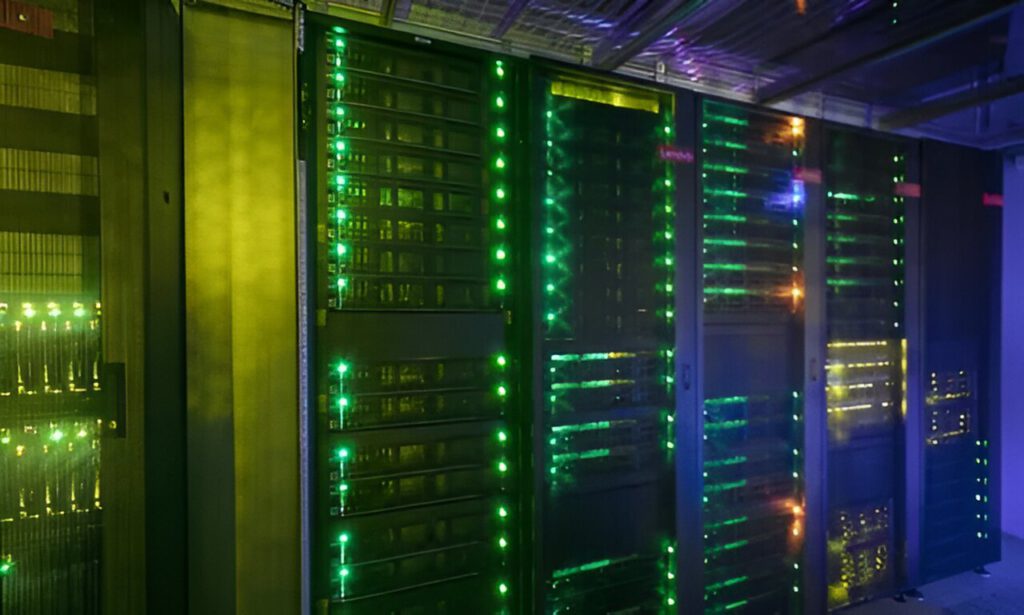University of Innsbruck’s HPC cluster LEO 5 delivers up to 250 billion calculations per second. User access, resource management and process flows follow international standards and are therefore compatible with other HPC facilities. Credit: University of Innsbruck
The University of Innsbruck and spin-off company AQT have joined forces to become the first in Austria to integrate quantum computers into a high-performance computing (HPC) environment. This hybrid infrastructure of supercomputers and quantum computers can now be used to solve complex problems in a variety of fields, including chemistry, materials science and optimization.
The demand for computing power is constantly increasing, as is the consumption of resources to support these calculations. The processor clock speeds of traditional computers (typically several GHz) seem to be reaching their limits.
Performance improvements over the past decade have focused primarily on parallelizing tasks using multi-core systems operated as high-speed networked multi-node computing clusters in HPC centers, but computing power scales only roughly linearly with the number of nodes.
Development has shifted away from a focus on homogenous setups of identical nodes and towards operating heterogeneous infrastructures consisting of a variety of specialized nodes or accelerators, such as GPUs or NPUs, each optimized for a specific computation.
“With the advent of quantum computers and the possibility of solving certain problems in chemistry and materials science much faster than before, quantum accelerators for HPC computers are a new and very exciting possibility,” explains quantum physicist Thomas Montz, assistant professor at the University of Innsbruck and CEO of the spin-off company AQT.
Researchers and developers from the University of Innsbruck and AQT have begun work on integrating quantum computers into HPC environments as part of the HPQC project.
Building on standardized interfaces for quantum computers, the Innsbruck team successfully interfaced the UIBK-operated computing cluster “LEO5” with AQT’s “IBEX Q1” quantum computer. This work lays the foundation for future research and development into quantum-enabled solutions within heterogeneous infrastructures.
“The successful integration of quantum computers into high-performance computing environments marks an important milestone for research and technological development in Austria and Europe. It opens up entirely new possibilities for mastering complex scientific and industrial challenges and shaping the future of computing.”
“This project is an impressive demonstration of the innovative power and technological advantage our country can achieve and shows the EU’s great potential and independence in quantum technologies. FFG is proud to support this pioneering development,” said Henrietta Eggers, Managing Director of FFG.
Hybrid Supercomputers for Research and Education
This infrastructure is currently being operated and expanded within the framework of the HPQC project, which is focused on demonstrating hybrid quantum solutions: consortium partners such as Math.Tec GmbH in Vienna and a research group led by Professor Ivona Brandić at the Vienna University of Technology have direct access to this hybrid HPC-QC framework to perform their calculations.
The consortium is built on a foundation of standardized resource and user management, which will increase the potential for more users to benefit from the Innsbruck infrastructure. In addition to research and development, the solutions provided will also be applied in new course offerings by the faculties of Computer Science, Physics and Chemistry to train the next generation of quantum-aware researchers and engineers.
“The HPQC project provides easy access to the HPC infrastructure in Innsbruck. Our employees can run calculations within the hybrid infrastructure and investigate new solutions to logistics problems. One of our researchers, Dr. Angelika Widl, routinely pursues unexplored approaches thanks to the previously uncharted possibilities in Innsbruck,” explains Dr. Karl Knall, CEO of Math.Tec GmbH, a partner in the HPQC project.
“Quantum computers follow a new computational paradigm and offer new solutions, some of which outperform the best classical algorithms. However, integrating these accelerators into classical computing infrastructure and finding hybrid solutions that combine the best of both worlds is an unexplored area of research.
“The HPQC project gives us the possibility to spearhead research and development in this field that is both academically and economically interesting,” says Professor Ivona Brandić, Group Leader for High Performance Computing Systems at TU Vienna.
AQT delivers the first quantum computers compatible with standardized 19″ rack infrastructure. These systems can be easily installed in HPC or data centers. Operating at room temperature and consuming less than 2 kW, this green quantum computer offers the largest quantum volume within Europe. Credit: Dieter Kühl/AQT
Accelerators for Traditional Computer Infrastructure
Traditional HPC clusters are typically installed in standardized 19″ racks. Although these devices provide incredible computational power, they scale unfavorably to the point that certain problems in nature, especially those that must be described by quantum mechanics, can only be solved approximately or not at all.
These challenges include understanding room temperature superconductivity, which, if realized, is expected to revolutionize all areas that use electronic devices. Other applications include chemical processes such as nitrogen fixation to develop cost- and energy-efficient fertilizers, and carbon bonding to combat climate change.
With a growing number of proof-of-concept quantum computers in the experimental stage, AQT has developed the first 19″ rack-compatible quantum computer. Integrating quantum computers into HPC infrastructure allows researchers and developers to take advantage of both superior classical computing power and increased speed for certain problem classes.
The challenge is to balance the workload between these two very different computational approaches: which parts of a computational problem are best handled by a classical computer, and at what point should the computation be transferred to a quantum processor?Interfacing between classical and quantum infrastructure allows researchers to creatively discover, adapt, and extend the interplay between classical and quantum hardware.
Courtesy of University of Innsbruck
Source: Hybrid Supercomputer: Researchers Integrate Quantum Computers into High-Performance Computing Environments (July 23, 2024) Retrieved July 23, 2024 from https://techxplore.com/news/2024-07-hybrid-supercomputer-quantum-high-environment.html
This document is subject to copyright. It may not be reproduced without written permission, except for fair dealing for the purposes of personal study or research. The content is provided for informational purposes only.

